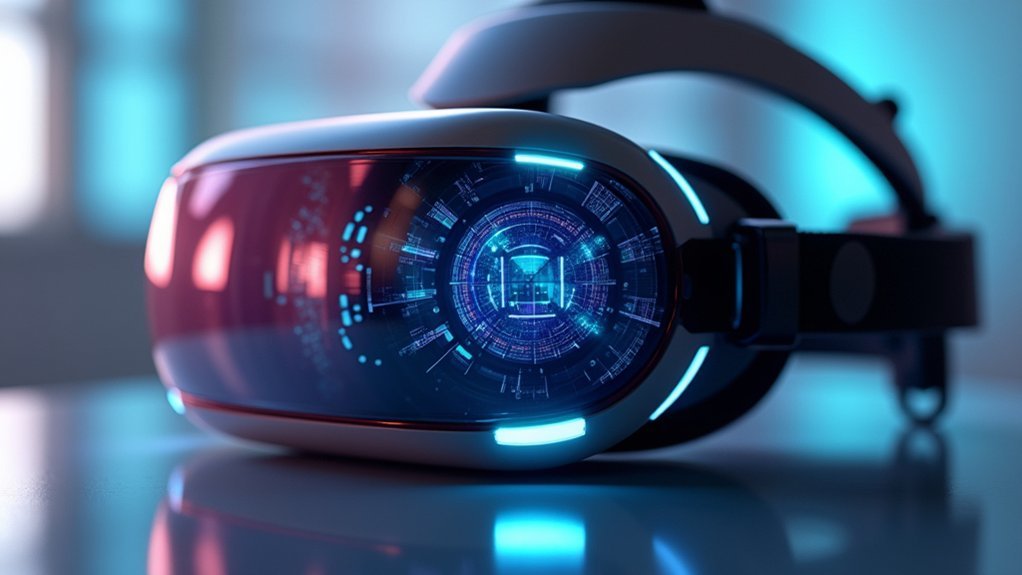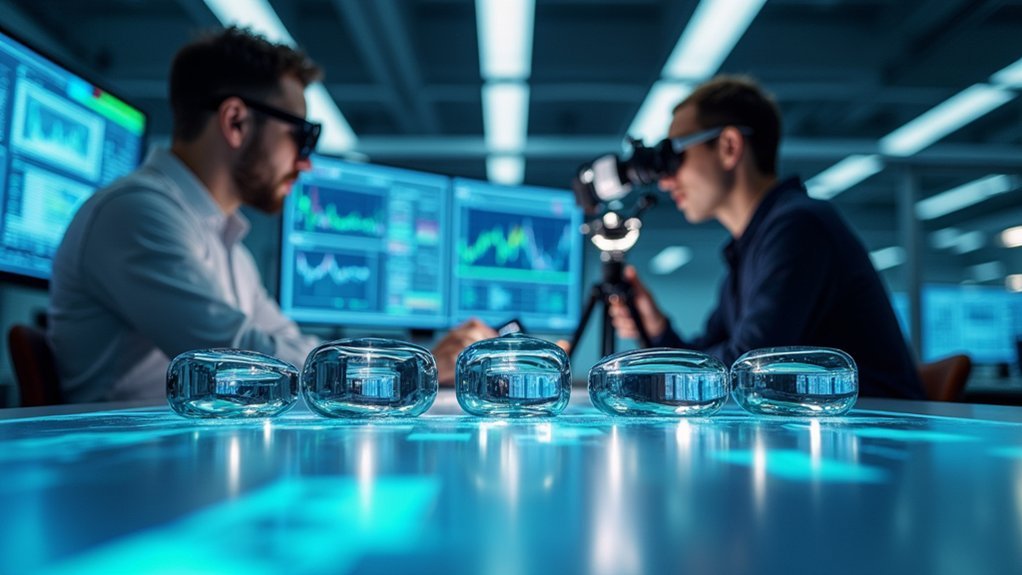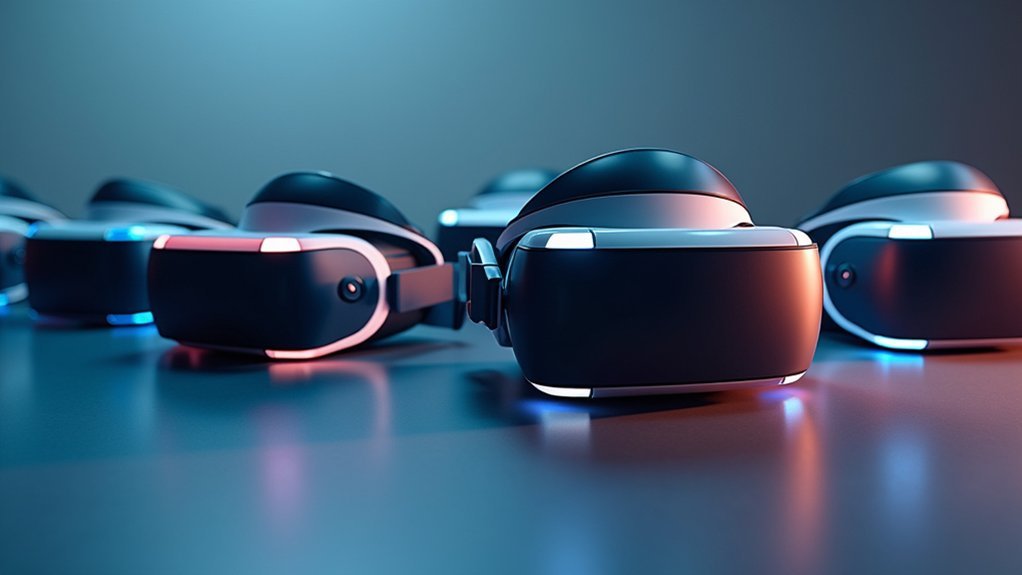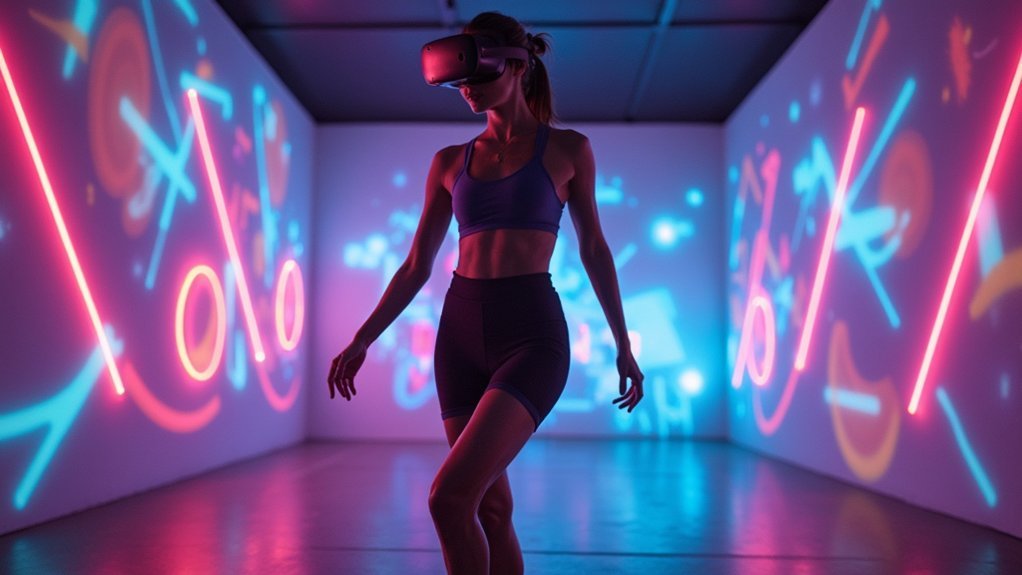You can eliminate VR lens distortion using seven advanced methods: fragment-based pixel processing that handles 2 million pixels individually, mesh-based vertex interpolation using sparse 40×20 geometry grids, direct vertex displacement with custom shaders, polynomial mathematical models like Brown-Conrady for radial correction, feature-based detection systems, deep learning algorithms including CNN and GAN methodologies for adaptive compensation, and dynamic calibration systems that adjust parameters in real-time based on your head movements and eye tracking data for personalized optimization.
Fragment-Based Pixel Processing for Real-Time Distortion Correction
Fragment-based pixel processing tackles real-time distortion correction through a computationally intensive two-pass rendering approach that processes each pixel individually.
You’ll find this method renders both left and right eyes onto textures before applying fragment shaders to adjust each pixel’s position inward relative to the eye’s centroid.
While this fragment-based technique creates immersive experiences, you’ll face significant performance challenges since it processes approximately 2 million pixels compared to mesh-based alternatives that handle only 800 vertices.
Fragment-based processing handles 2 million pixels versus mesh-based alternatives with only 800 vertices, creating significant performance trade-offs.
The WebVR Boilerplate’s first version utilized this approach, demonstrating its early importance in VR development.
However, you’ll experience increased latency and reduced frame rates, especially in high-resolution VR applications where the computational demand becomes prohibitive for real-time performance.
Mesh-Based Vertex Interpolation Using Sparse Geometry
Mesh-based vertex interpolation revolutionizes VR distortion correction by processing only 800 vertices through a sparse 40×20 geometry grid instead of millions of individual pixels.
You’ll experience performance improvements up to three magnitudes compared to traditional pixel-based approaches, dramatically reducing GPU computational load.
When you implement this method, you’re distorting mesh vertices according to your camera’s perspective, then leveraging GPU interpolation to create smooth shifts and accurate virtual environment representation.
This technique eliminates the need for heavy computational resources while maintaining visual quality.
You can see this approach successfully implemented in WebVR Polyfill, where it outperforms fragment-based methods by reducing direct rendering computation.
The result? You’ll achieve higher frame rates and smoother visuals in your VR applications without sacrificing distortion correction accuracy.
Direct Vertex Displacement With Custom Shader Implementation

While traditional approaches require processing millions of pixels, direct vertex displacement with custom shader implementation transforms your VR distortion correction by manipulating geometry directly at the vertex level.
You’ll achieve significant performance gains by processing approximately 800 vertices instead of 2 million pixels, eliminating intermediate texture computations entirely.
Your custom vertex shader modifies 3D model geometry in real-time, adjusting for radial distortion based on camera position.
You’ll need adequate mesh density—a 40×20 grid works effectively—to maintain visual quality during distortion corrections.
This direct vertex displacement method proves particularly valuable for VR applications requiring sharp renderings and minimal latency.
Projects like Cardboard Design Lab and VR View demonstrate this technique’s real-world effectiveness, delivering immersive experiences through efficient geometry-based distortion correction.
Polynomial Mathematical Models for Radial and Tangential Correction
Beyond geometry manipulation, polynomial mathematical models provide the mathematical foundation for precise radial and tangential distortion correction in VR lens systems.
You’ll primarily work with two established approaches: the Brown-Conrady model and the Kannala-Brandt model.
The Brown-Conrady model uses a simplified polynomial approach with the first two terms to approximate distortion parameters, making it practical for standard VR applications. However, when you’re dealing with ultra-wide VR lenses, you’ll need the Kannala-Brandt model’s more sophisticated 23-parameter fit.
Both models transform pixel coordinates into normalized coordinates to effectively rectify radial and tangential distortion.
You’ll implement these polynomial corrections by calculating distortion coefficients specific to your VR headset’s optical characteristics, ensuring accurate visual reproduction and reducing eye strain during extended VR sessions.
Feature-Based Detection and Parameter Estimation Methods

When polynomial models lack sufficient calibration data, feature-based detection methods offer you an alternative approach that extracts distortion parameters directly from image content.
You’ll leverage distinctive characteristics like corners and edges in fisheye images to infer distortion coefficients through corner detection and feature point matching techniques.
These feature-based methods analyze relationships between distorted and undistorted image coordinates to improve parameter estimation accuracy. You can implement robust algorithms like RANSAC to handle feature correspondences effectively, even without pre-existing calibration data.
Direct methods such as Horizontal Expansion and Latitude-Longitude Mapping help you analyze specific image features for parameter estimation.
You’ll achieve enhanced rectification accuracy with these techniques, making them particularly valuable for real-time VR applications where calibration data isn’t readily available.
Deep Learning Algorithms for Adaptive Distortion Compensation
You’ll find that deep learning algorithms offer sophisticated approaches to adaptive distortion compensation through two primary methodologies.
CNN training techniques rely on large datasets of paired distorted and undistorted images to learn complex correction patterns that traditional methods can’t capture.
GAN implementation strategies take this further by using generator-discriminator frameworks to create real-time correction systems that adapt dynamically to varying distortion patterns in VR environments.
CNN Training Methodologies
While traditional geometric methods rely on predetermined mathematical models, Convolutional Neural Networks offer a data-driven approach that adapts to complex distortion patterns through supervised learning.
When implementing CNN training methodologies for lens distortions, you’ll need to carefully consider your training strategy to achieve ideal correction results.
Effective CNN training for VR distortion correction requires:
- Paired datasets of distorted and undistorted images with substantial computational resources
- Synthesized images with radial distortion patterns to expand training data diversity
- Multi-task learning approaches combining semantic segmentation, boundary prediction, and object detection
- Fast level set models integration for correcting intensity inhomogeneity during processing
- Attention-based networks like ANAFNet for addressing deblurring challenges in fisheye imagery
You’ll find these methodologies greatly improve distortion compensation compared to traditional approaches.
GAN Implementation Strategies
Generative Adversarial Networks revolutionize VR lens distortion correction by creating a competitive learning environment where a generator network produces undistorted images while a discriminator network evaluates their authenticity.
You’ll find the Distortion Rectification GAN (DR-GAN) framework particularly effective for addressing radial lens distortion through end-to-end training processes.
When implementing GAN strategies, you can leverage parallel CNN architectures that simultaneously remove perspective distortion while predicting transformation matrix parameters. This approach enhances correction flexibility greatly.
You’ll benefit from integrating self-supervised learning techniques within your GAN framework, enabling accurate depth and motion estimation without requiring prior camera model knowledge.
For challenging environments, you should consider distortion-guided networks that employ generative adversarial methods to restore distortion-free images, improving overall image quality in your VR applications.
Dynamic Calibration Systems for Individual User Optimization
You’ll achieve ideal VR visual quality when dynamic calibration systems adjust lens distortion parameters in real-time based on your specific usage patterns.
These systems create personalized distortion maps by continuously monitoring your head movements, eye tracking data, and interaction behaviors.
Your VR experience becomes uniquely tailored as the system learns your preferences and automatically fine-tunes distortion correction without requiring manual intervention.
Real-Time Parameter Adjustment
As VR technology advances toward personalized experiences, real-time parameter adjustment systems have emerged as essential components for optimizing lens distortion correction on an individual basis.
These sophisticated systems dynamically calibrate cameras and sensors to deliver customized visual experiences that adapt to your unique viewing characteristics and environmental conditions.
Key features of real-time parameter adjustment include:
- Machine learning algorithms that continuously fine-tune k1 and k2 distortion coefficients based on your feedback
- Head movement tracking sensors that adjust parameters on-the-fly for consistent visual quality
- GPU-accelerated computations ensuring smooth performance during rapid distortion corrections
- Tracking hub integration providing immediate data for algorithm adjustments
- Dynamic calibration techniques that respond to changing lighting and environmental factors
You’ll experience enhanced immersion and comfort through these adaptive systems.
Personalized Distortion Mapping
Building on these adaptive capabilities, personalized distortion mapping takes individual enhancement to the next level by creating custom calibration profiles tailored to your specific anatomical characteristics.
These dynamic systems continuously monitor your eye positions and head movements, using real-time feedback to adjust lens parameters that minimize distortion effects unique to your facial structure.
Machine learning algorithms analyze your interaction patterns and preferences, predicting ideal settings that enhance comfort and immersion. This personalized approach markedly improves visual accuracy, especially during precision tasks requiring fine detail recognition.
The technology’s growing implementation in modern VR headsets demonstrates how advanced sensor technology enables responsive, user-specific adjustments that transform your virtual experience through intelligent distortion correction.
Frequently Asked Questions
What Are the Techniques of Distortion Correction?
You’ll find distortion correction uses polynomial models like Brown-Conrady, feature-based methods with corner detection, direct RANSAC estimation, and deep learning approaches including CNNs and GANs for thorough image rectification.
How Do You Correct Lens Distortion?
You’ll apply polynomial models like Brown-Conrady to map distorted pixels to corrected positions, use OpenCV’s undistort function with calibration parameters, or employ deep learning networks trained on distorted-undistorted image pairs.
How to Reduce Distortion in Lenses?
You’ll reduce lens distortion by using higher-quality glass elements, implementing aspherical lens designs, adding corrective elements to your optical system, and optimizing focal lengths for your specific application requirements.
What Is the App That Fixes Lens Distortion?
You can use the OSVR distortionizer program to fix lens distortion in VR headsets. It creates accurate distortion profiles that eliminate visual artifacts and improve your virtual reality viewing experience considerably.





Leave a Reply